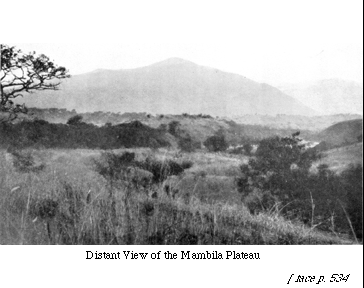Go to previous page
534
was, after discussion, accepted1. I note that Captain Izard, who has made a close study of the Mambila (and if I may say so has done work of outstanding value), confines the use of the term "Torbi" to the villagers of Kuma. In this, I think, he is mistaken.
The Mambila groups all speak dialects of the same language; but there are variations by which we can make a rough classification into two groups, a Northern and Southern. The Northern group uses the words Mwandi [6] for Sun and Nama [7]
for Sun and Nama [7]  for God, [Notes6] whereas the Southern group uses the words Lu and Chang respectively. There are other variations which will be seen by a study of the vocabularies (e.g. that wuni = head in the Northern group and gur in the Southern group) and it will appear later also that there are cultural distinctions between the two groups (e.g. in house building). In some cases (e.g. at Kabri) there is a fusion between the two groups. On this basis we may include the following villages in the Northern group: Jabu, Gikaun, Kuma, Baso, Yurum, Ngubin, Dembi, Tem, Titong, and Kabri. The Southern group would include (a) Warwar, Vakude, Tamnyang, and Mbamgam, and (b) Wa, (Leme), Genbu, Mverrip, Bou, Bar, Teb, and San. This latter section is known collectively as Tagbo (Lagubi[8]
for God, [Notes6] whereas the Southern group uses the words Lu and Chang respectively. There are other variations which will be seen by a study of the vocabularies (e.g. that wuni = head in the Northern group and gur in the Southern group) and it will appear later also that there are cultural distinctions between the two groups (e.g. in house building). In some cases (e.g. at Kabri) there is a fusion between the two groups. On this basis we may include the following villages in the Northern group: Jabu, Gikaun, Kuma, Baso, Yurum, Ngubin, Dembi, Tem, Titong, and Kabri. The Southern group would include (a) Warwar, Vakude, Tamnyang, and Mbamgam, and (b) Wa, (Leme), Genbu, Mverrip, Bou, Bar, Teb, and San. This latter section is known collectively as Tagbo (Lagubi[8] ) or Tongbo[9]
) or Tongbo[9] .
.
[Notes7] All these groups are administered by the Emir of Adamawa, through the district head of Gashaka, who is also a Fulani. But formerly the Mambila had no relations either with Gashaka or with the Emirs of Adamawa. Those who became subject to the Fulani acknowledged only the Fulani governors of Banyo, which is now included in French Cameroons (but the Fulani of Banyo were to some extent subordinate to the Emirs of Adamawa).
It is stated that there are other groups of Mambila in the French Cameroons (viz. at Sangkola, Shone, Ata, Lingam, and Kakara), [Notes8] and also in the Bamenda division of British Cameroons (viz. at Nyoro, Gongkor and Birpa).
Closely connected with the Mambila, though not described as Mambila, are the villagers of Kamkam and Magu [10] . This group formerly occupied the site which is now the Fulani settlement of Guroje. When attacked by the Fulani of Banyo one group fled
. This group formerly occupied the site which is now the Fulani settlement of Guroje. When attacked by the Fulani of Banyo one group fled
1The blacksmith groups who are an immigrant caste describe the Mambila as Tu-turu. The Fulani may have adopted this term from the blacksmiths dropping the prefix "Tu" and adding their suffix "be".
plate 55 
Go to next page
 for Sun and Nama [7]
for Sun and Nama [7]  for God, [Notes6] whereas the Southern group uses the words Lu and Chang respectively. There are other variations which will be seen by a study of the vocabularies (e.g. that wuni = head in the Northern group and gur in the Southern group) and it will appear later also that there are cultural distinctions between the two groups (e.g. in house building). In some cases (e.g. at Kabri) there is a fusion between the two groups. On this basis we may include the following villages in the Northern group: Jabu, Gikaun, Kuma, Baso, Yurum, Ngubin, Dembi, Tem, Titong, and Kabri. The Southern group would include (a) Warwar, Vakude, Tamnyang, and Mbamgam, and (b) Wa, (Leme), Genbu, Mverrip, Bou, Bar, Teb, and San. This latter section is known collectively as Tagbo (Lagubi[8]
for God, [Notes6] whereas the Southern group uses the words Lu and Chang respectively. There are other variations which will be seen by a study of the vocabularies (e.g. that wuni = head in the Northern group and gur in the Southern group) and it will appear later also that there are cultural distinctions between the two groups (e.g. in house building). In some cases (e.g. at Kabri) there is a fusion between the two groups. On this basis we may include the following villages in the Northern group: Jabu, Gikaun, Kuma, Baso, Yurum, Ngubin, Dembi, Tem, Titong, and Kabri. The Southern group would include (a) Warwar, Vakude, Tamnyang, and Mbamgam, and (b) Wa, (Leme), Genbu, Mverrip, Bou, Bar, Teb, and San. This latter section is known collectively as Tagbo (Lagubi[8] ) or Tongbo[9]
) or Tongbo[9] .
.
